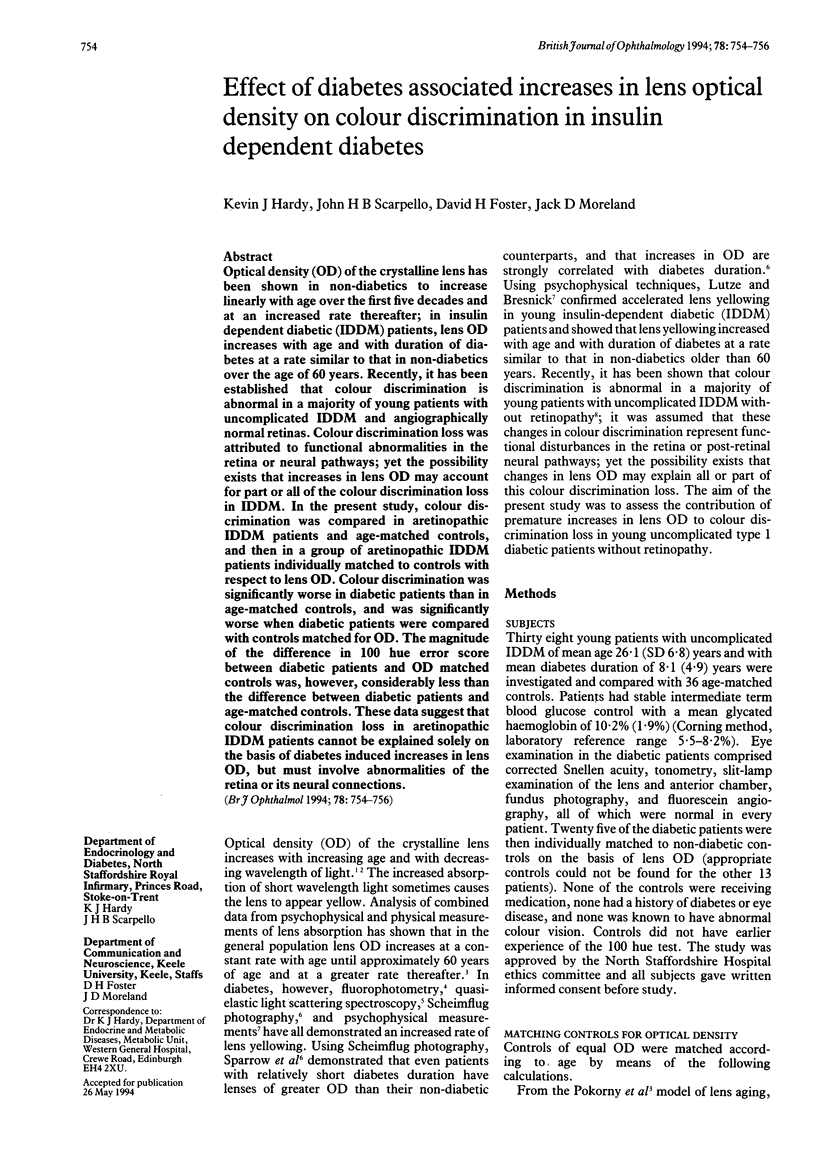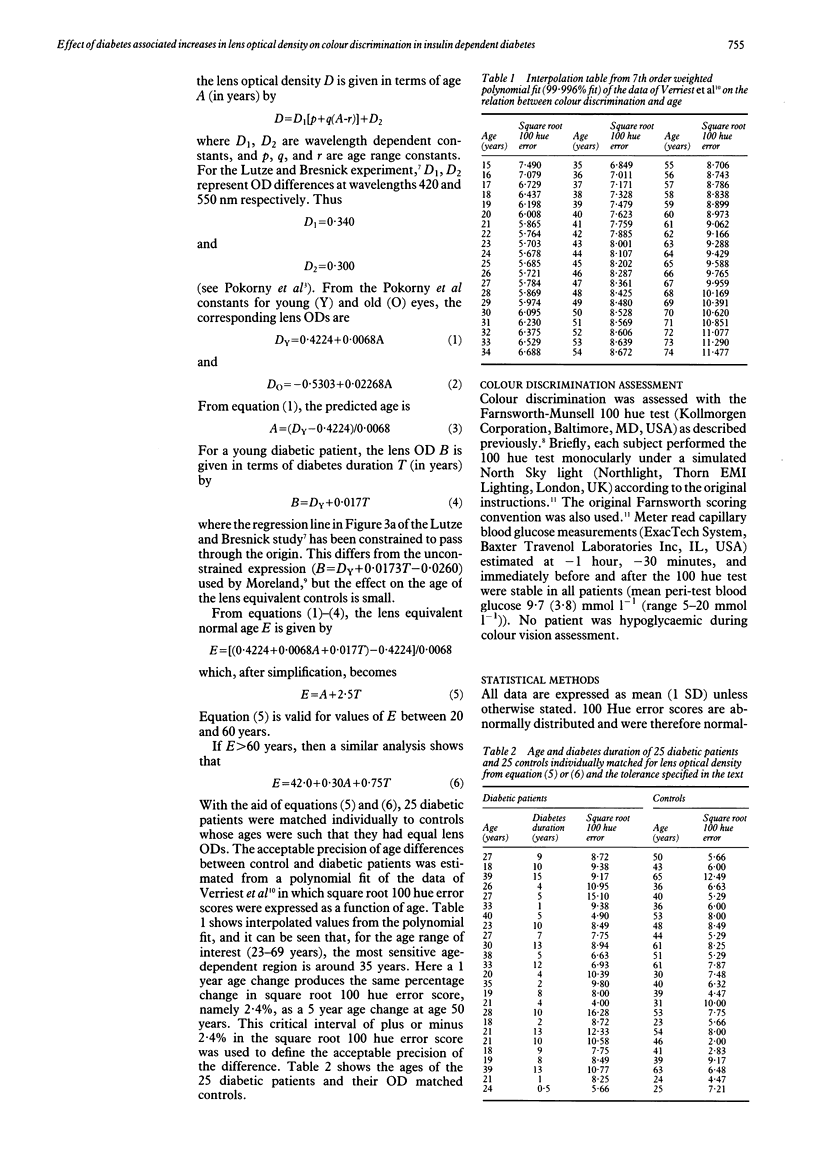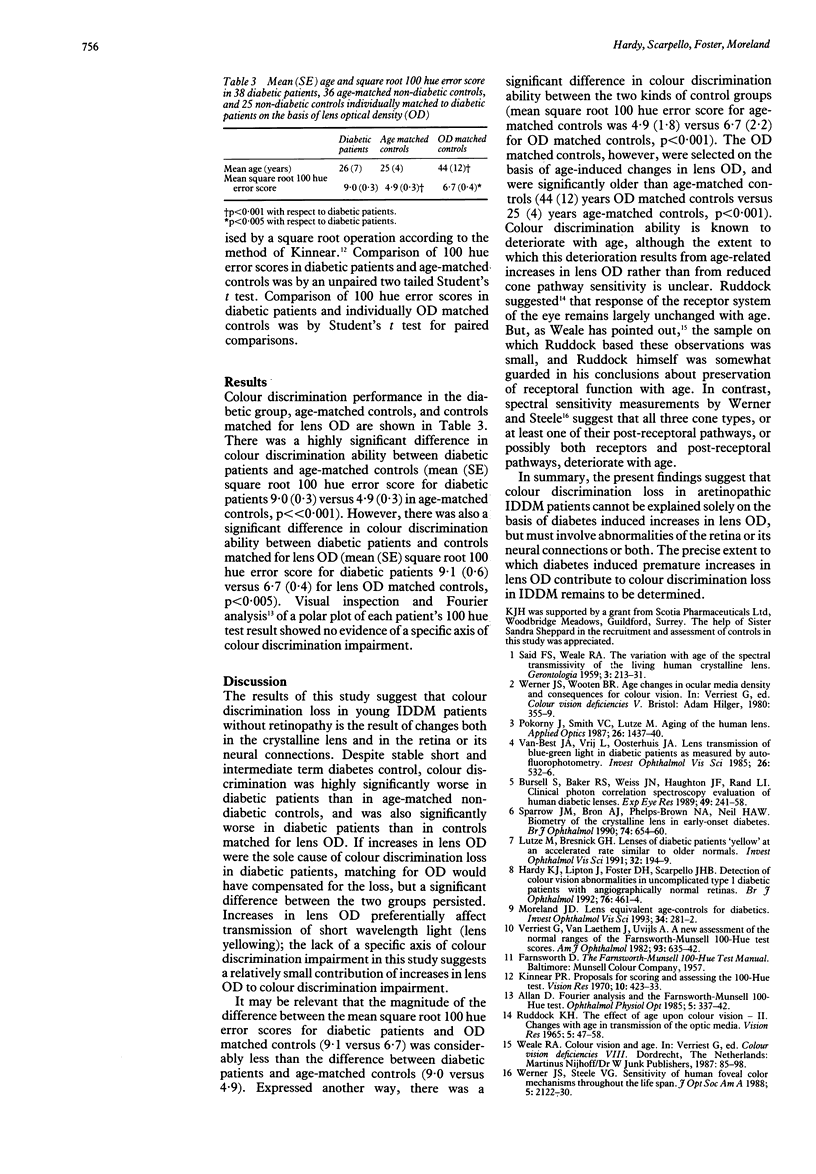Abstract
Optical density (OD) of the crystalline lens has been shown in non-diabetics to increase linearly with age over the first five decades and at an increased rate thereafter; in insulin dependent diabetic (IDDM) patients, lens OD increases with age and with duration of diabetes at a rate similar to that in non-diabetics over the age of 60 years. Recently, it has been established that colour discrimination is abnormal in a majority of young patients with uncomplicated IDDM and angiographically normal retinas. Colour discrimination loss was attributed to functional abnormalities in the retina or neural pathways; yet the possibility exists that increases in lens OD may account for part or all of the colour discrimination loss in IDDM. In the present study, colour discrimination was compared in aretinopathic IDDM patients and age-matched controls, and then in a group of aretinopathic IDDM patients individually matched to controls with respect to lens OD. Colour discrimination was significantly worse in diabetic patients than in age-matched controls, and was significantly worse when diabetic patients were compared with controls matched for OD. The magnitude of the difference in 100 hue error score between diabetic patients and OD matched controls was, however, considerably less than the difference between diabetic patients and age-matched controls. These data suggest that colour discrimination loss in aretinopathic IDDM patients cannot be explained solely on the basis of diabetes induced increases in lens OD, but must involve abnormalities of the retina or its neural connections.
Full text
PDF


Selected References
These references are in PubMed. This may not be the complete list of references from this article.
- Bursell S. E., Baker R. S., Weiss J. N., Haughton J. F., Rand L. I. Clinical photon correlation spectroscopy evaluation of human diabetic lenses. Exp Eye Res. 1989 Aug;49(2):241–258. doi: 10.1016/0014-4835(89)90094-8. [DOI] [PubMed] [Google Scholar]
- Hardy K. J., Lipton J., Scase M. O., Foster D. H., Scarpello J. H. Detection of colour vision abnormalities in uncomplicated type 1 diabetic patients with angiographically normal retinas. Br J Ophthalmol. 1992 Aug;76(8):461–464. doi: 10.1136/bjo.76.8.461. [DOI] [PMC free article] [PubMed] [Google Scholar]
- Kinnear P. R. Proposals for scoring and assessing the 100-Hue test. Vision Res. 1970 May;10(5):423–433. doi: 10.1016/0042-6989(70)90123-9. [DOI] [PubMed] [Google Scholar]
- Lutze M., Bresnick G. H. Lenses of diabetic patients "yellow" at an accelerated rate similar to older normals. Invest Ophthalmol Vis Sci. 1991 Jan;32(1):194–199. [PubMed] [Google Scholar]
- Moreland J. D. Lens-equivalent age controls for diabetics. Invest Ophthalmol Vis Sci. 1993 Feb;34(2):281–282. [PubMed] [Google Scholar]
- Ruddock K. H. The effect of age upon colour vision. II. Changes with age in light transmission of the ocular media. Vision Res. 1965 Jan;5(1):47–58. doi: 10.1016/0042-6989(65)90074-x. [DOI] [PubMed] [Google Scholar]
- SAID F. S., WEALE R. A. The variation with age of the spectral transmissivity of the living human crystalline lens. Gerontologia. 1959;3:213–231. doi: 10.1159/000210900. [DOI] [PubMed] [Google Scholar]
- Sparrow J. M., Bron A. J., Brown N. A., Neil H. A. Biometry of the crystalline lens in early-onset diabetes. Br J Ophthalmol. 1990 Nov;74(11):654–660. doi: 10.1136/bjo.74.11.654. [DOI] [PMC free article] [PubMed] [Google Scholar]
- Verriest G., Van Laethem J., Uvijls A. A new assessment of the normal ranges of the Farnsworth-Munsell 100-hue test scores. Am J Ophthalmol. 1982 May;93(5):635–642. doi: 10.1016/s0002-9394(14)77380-5. [DOI] [PubMed] [Google Scholar]
- van Best J. A., Vrij L., Oosterhuis J. A. Lens transmission of blue-green light in diabetic patients as measured by autofluorophotometry. Invest Ophthalmol Vis Sci. 1985 Apr;26(4):532–536. [PubMed] [Google Scholar]


